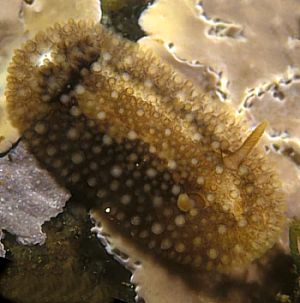
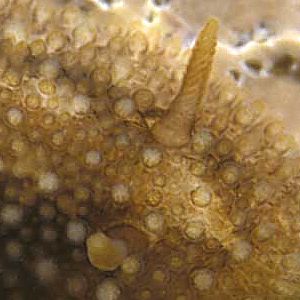
Onchidoris bilamellata
(Linnaeus, 1767)
Order: NUDIBRANCHIA
Suborder: DORIDINA
Superfamily: ANADORIDOIDEA
Family: Onchidorididae
DISTRIBUTION
North Atlantic - Britain and France north along Norwegiian coast to White Sea, Spitzbergen, west to Iceland, Greenland and down North American coast to Connecticut. Also North Pacific with records from Bering Sea, Alaska, Pujet Sound south to California.
PHOTO
off Mount Desert Island, New England, USA [Atlantic coast]., 2-3 cm long. Photo: Paul Young
Reaches 40mm in length and found from intertidal to 20m. Often very abundant locally, feeding on barnacles (Elminius, Balanus).
Reference:
•Bleakney, J.S. (1996) Sea Slugs of Atlantic Canada and the Gulf of Maine,
• Bleakney, J.S. & Saunders, C.L. (1978) Life history observations on the nudibranch mollusc Onchidoris bilamellata in the intertidal zone of Nova Scotia. Beaufortia, Zoological Museum Univ., Amsterdam, 92: 82-85.
• Crampton, D.M. (1977) Functional anatomy of the buccal apparatus of Onchidoris bilamellata (Mollusca: Opisthobranchia). Transactions of the Zoological Society of London, 34: 45-86.
• Pelseneer, P. (1922) Sur une habitude de Doris bilamellata. Annls. Soc. roy. zool. Belg., 53: 28-32
• Potts, G.W. (1981) The anatomy of respiratory structures in the dorid nudibranchs, Onchidoris bilamellata and Archidoris pseudoargus, with details of the epidermal glands. Journal of the Marine Biological Association, United Kingdom, 61: 959-982.
• Thompson, T.E. (1984) Migrations of Onchidoris bilamellata during tidal emersion: a refutation. J. Moll. Stud., 50(2): 123.
• Thompson, T.E. & Brown, G.H. (1984) Biology of Opisthobranch Molluscs, Vol 2. Ray Society: London.
• Todd, C.D. (1979) The population ecology of Onchidoris bilamellata (L). (Gastropoda: Nudibranchia). J. Exp. Mar. Biol. Ecol. 41(3): 213-255.
Rudman, W.B., 2001 (June 18) Onchidoris bilamellata (Linnaeus, 1767). [In] Sea Slug Forum. Australian Museum, Sydney. Available from http://www.seaslugforum.net/find/onchbila
Related messages
Onchidoris bilamellata aggregation in Maine, USA
September 9, 2009
From: Drew Villeneuve
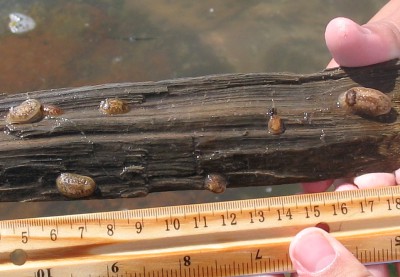
Dear Bill,
Here are some pictures of Onchidoris bilamellata from a project studying population density in intertidal areas that I took a year ago. Just thought you might like the nudis on the driftwood and the huge population density in the pools - up to 1023 individuals in a space of 915 square meters. A lot of these pictures are out of focus because I didn't have an underwater camera with me - and it would have been useless anyways, judging from the shallowness of the water.
Locality: Bar Island, Deer Island, Maine, USA, Penobscot Bay, Atlantic Ocean, intertidal, 23 August 2008, Rocky Shore. Length: ~1-2.5 cm. Photographer: Drew Villeneuve
Regards,
Drew Villeneuve,
St. Albans School
kapsberger@gmail.com
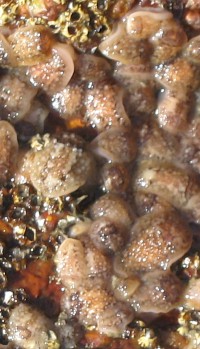
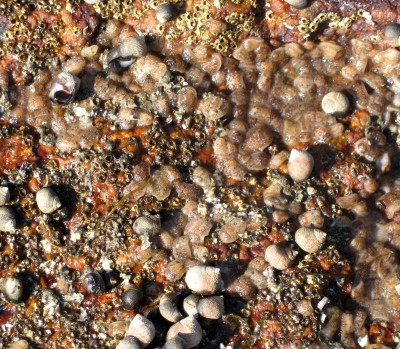
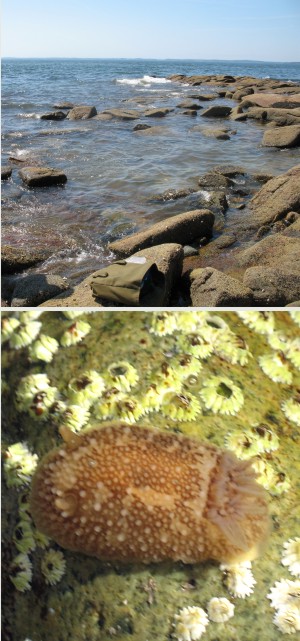
Thanks Drew,
When I see photos like these I can understand why ecologists in the northern hemisphere have been attracted to Onchidoris bilamellata. We can see in your middle photos that the animals cluster into depressions and channels in the rock at low tide, which I guess is to keep them moist.
We don't get any shallow water dorids appearing in these densities down here in Australia and New Zealand, but we often find Sea Hares doing so.
Best wishes,
Bill Rudman
Re: Conga lines - Onchidoris bilamellata
March 19, 2008
From: David L. Washburn
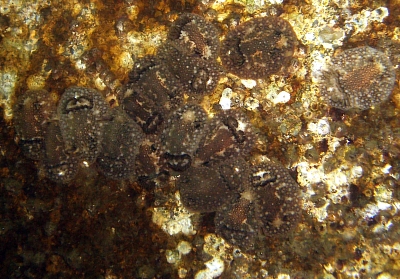
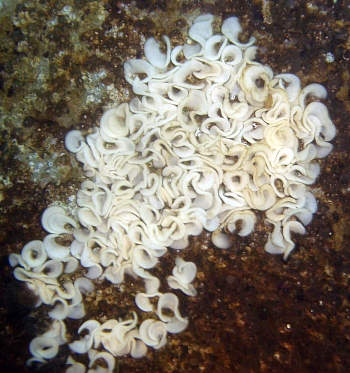
Concerning message #5688:
Well, if those guys are doing a conga line, I guess these guys are doing a waltz? Actually, knowing the way nudibranchs spawn head-to-tail, it's probably more like an orgy. Whether or not the huge bunch of egg ribbons are the result of this convention or another, I don't know.
Locality: Warren Avenue Bridge, Bremerton, Washington, 25 feet, Washington, USA, Puget Sound, 15 March 2008, Concrete bridge piling. Length: 1 inch. Photographer: Dave Washburn.
Dave Washburn
dwashbur@nyx.net
Washburn, D.L., 2008 (Mar 19) Re: Conga lines - Onchidoris bilamellata . [Message in] Sea Slug Forum. Australian Museum, Sydney. Available from http://www.seaslugforum.net/find/21459Thanks Dave,
If you look at the other messages concerning Onchidoris bilamellata you will see that mass movements mass matings and egg laying seem to be part of this species' way of life in much of the temperate waters of the northern hemisphere.
Best wishes,
Bill Rudman
Re: Onchidoris bilamellata spawning
December 5, 2007
From: J. Hildering & G. Miller
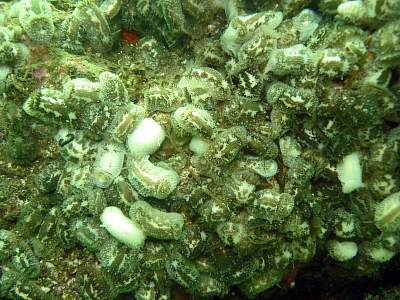
Concerning message #10454:
Hereby reporting the annual mass spawning event of Onchidoris bilamellata from British Columbia. All animals found above 20'. Amazing density and highly active. One image shows the trailing behaviour reported in the message "Conga lines of brown nudis in California."
Interesting too to find several Hermissenda crassicornis atop the masses (photo available if of interest.)
Locality: Bear Cove, 15', British Columbia, Canada, Pacific Ocean, 02 December 2007, Rocks. Length: 1.5 cm. Photographer: Jackie Hildering.
Jackie Hildering and Glen Miller
earthlingenterprises@telus.net
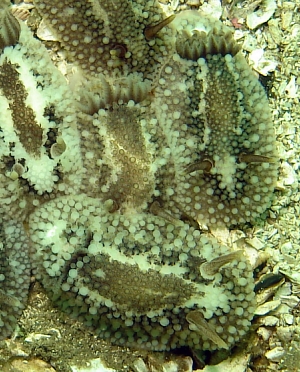
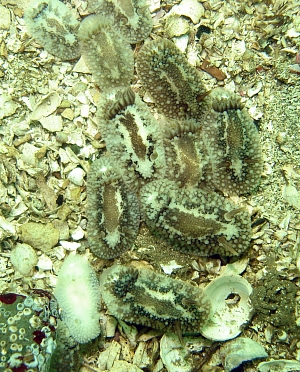
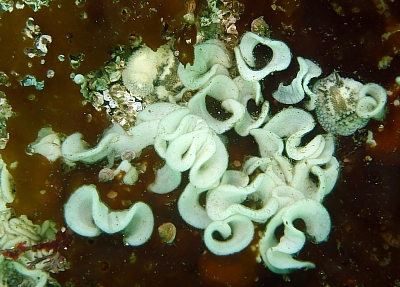
Dear Jackie and Glen,
This phenomenon must be an amazing sight - and so widespread in the northern hemisphere. If you think the Hermissenda were interested in the egg ribbons it would be useful to have a record of it on the Forum for future reference
Best wishes,
Bill Rudman
Onchidoris bilamellata from the Netherlands
November 30, 2007
From: Annette Kliphuis
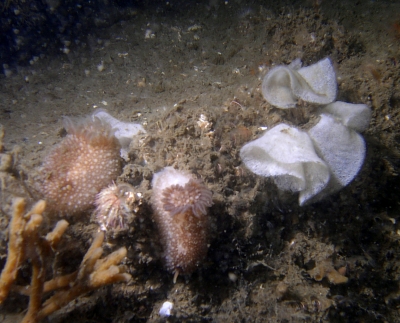
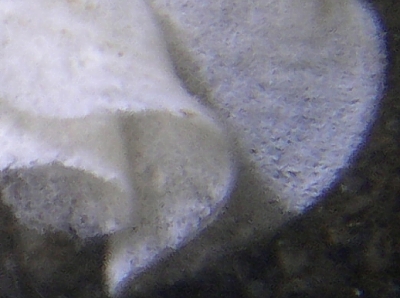
Dear Bill,
While going through my pictures I found this reasonable picture of Onchidoris bilamellata and their eggs encountered on a dive in the Grevelingen, the Netherlands. I hope you can use this sighting. They are my favourite nudi's, so cute :)
Locality: Grevelingen, 15 m, The Netherlands, june 2006, On rock covered with sand and hydroid growth. Photographer: Jeroen Ronk.
Annette Kliphuis
Annette.Kliphuis@wur.nl
Kliphuis, A.M.J., 2007 (Nov 30) Onchidoris bilamellata from the Netherlands. [Message in] Sea Slug Forum. Australian Museum, Sydney. Available from http://www.seaslugforum.net/find/21103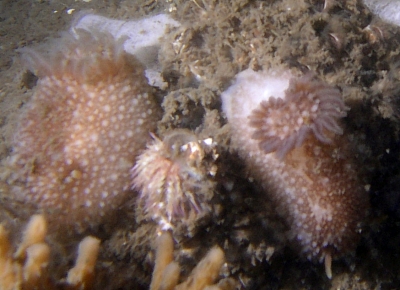
Thanks Annette,
Best wishes,
Bill Rudman
Re: Onchidoris bilamellata from Puget Sound
September 22, 2007
From: Dave Washburn
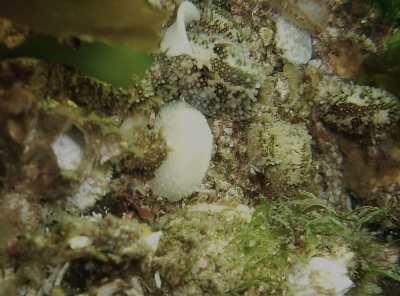
Concerning message #18900:
Lowell,
I found this cluster of Onchidoris bilamellata on a piling at Edmonds Oil Dock in the Sound. Note the pure white one in the middle. I asked around about it and was told that it's 99% certain it's the same species, just a color variant (albino?).
Locality: Edmonds Oil Dock, 12 ft, Washington, USA, Puget Sound, 17 July 2007, pilings in gravel bottom. Length: 1/2 inch. Photographer: Dave Washburn.
Dave Washburn.
dwashbur@nyx.net
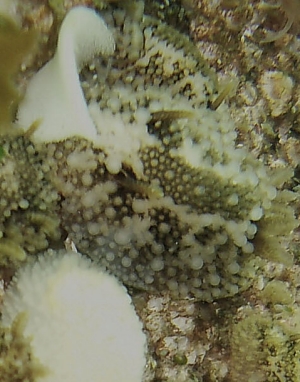
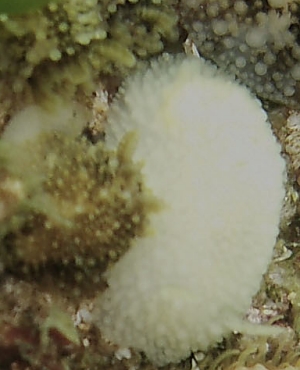
Thanks Dave,
Dave Behrens in his reply to that message said it was definitely what you might call an 'albino' form, so I guess that may be the case here.
Best wishes,
Bill Rudman
Re: Onchidoris bilamellata from Puget Sound
December 13, 2006
From: Lowell A Thomson
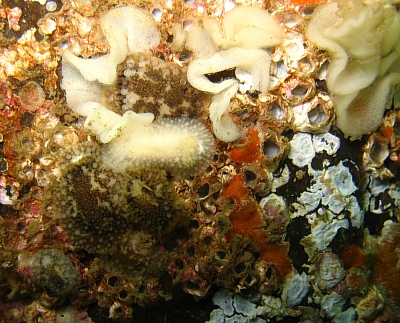
Concerning message #15949:
Yesterday I dove Harper's Ferry, just south of Port Orchard, Washington. In reading Jan's message, he mentions a "solitary" Onchidoris bilamellata. On the pilings at the pier here, there were definitely swarms of this nudibranch, with multiple specimens present in one picture, and egg ribbons aplenty. The first picture attached has at least seven individuals, and egg ribbon. I am curious about the pale nudibranch in the middle. Is this a color variant? Or is it possibly Onchidoris muricata? One reference (Eastern Pacific Nudibranchs; Behrens, D.W. and Hermosillo, A.) mentions "...rhinophores are yellow-orange tipped with yellow." The pale individual here does not appear to have yellow-orange tipped rhinosphores. A second picture from a different piling is attached, again with at least seven individuals. There is another pale nudibranch in this photo. However, this pale individual appears to have yellow-tipped rhinophores. Is this possibly Onchidoris muricata?
Locality: Harper's Ferry Fishing Pier, Port Orchard, 15-20 fsw, Washington State, USA, Puget Sound, 02 December 2006, On pilings.. Length: Less than 1 inch. Photographer: Lowell Thomson.
Thank you,
Lowell A Thomson.
scubadiver@huskychemist.org
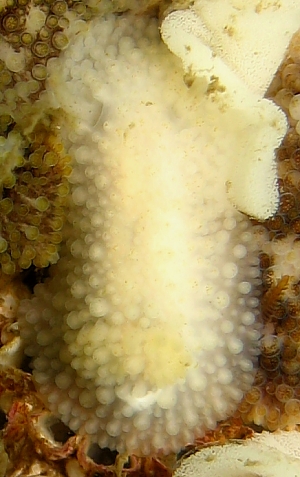
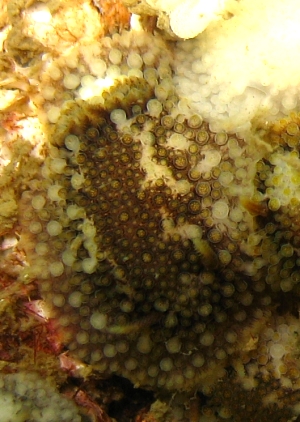
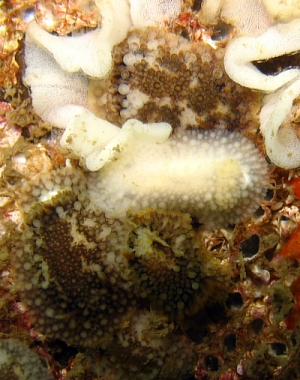
Hi Lowell,
This species is amazingly common around the Sound. Populations come and go with the settlement of barnacle larvae. These guys feed on the juvenile barnacles before they form their hard volcano shaped shell, then when the food resource is exhausted, lay hordes of eggs. On my first intertidal collecting trip in the Sound, we came across literally thousands of this dorid, huge masses of them and the egg masses were everywhere.
Concerning the light colored individuals - I have noted this also and have collected animals for genetic analysis. These lighter specimens are definitely O. bilamellata, but for some reason they are not capable of metabolizing the color pigments of their brethren. What is interesting to me is that co-occurring populations of another barnacle predator, the gastropod snail, Nucella lamellosa also have a mix of brown pigmented and white specimens. There must be something here. I hope to learn more soon.
Thanks,
Dave Behrens
Onchidoris bilamellata from Puget Sound
March 2, 2006
From: Jan Kocian
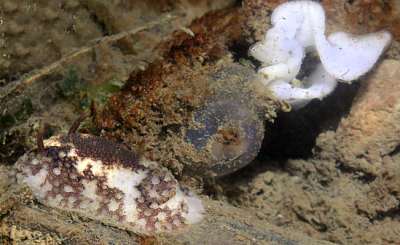
Hello Bill.
While checking on slug at the Lagoon Point harbor, I came across lonely Onchidoris bilamellata. After checking on Forum's Fact Sheet, I am looking forward the swarms everybody was reporting on in the past, especially since this is the first time for me ever.Locality: harbor, 10 feet, Washington USA, Puget Sound, NE Pacific Ocean, 22 February 2006, muddy. Length: 14 mm. Photographer: Jan Kocian.
Best regards,
Jan
honkoc@hotmail.com
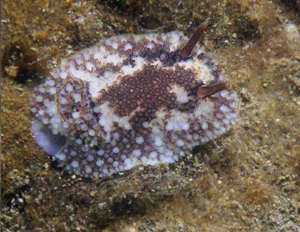
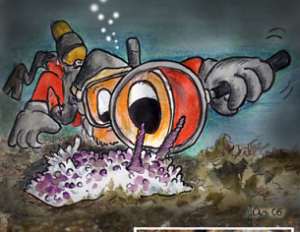
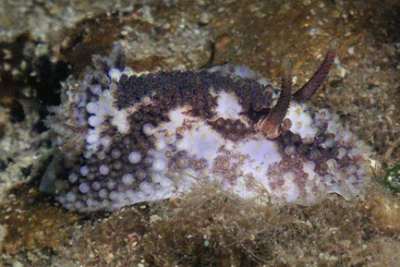
Dear Jan,
I hope it arrives in plenty and you are able to give it the Melibe treatment. Best wishes,
Bill Rudman
Mystery Nudibranch Behavior in Maryland
August 15, 2005
From: Vernon Heagy
A few weeks ago I was out on this wreck the Marine Electric off of Maryland, HUGE wreck, pretty famous [a show was just done on Deep Sea Detectives] The wreck is in 160fsw and relief for maybe 20 feet. So I did my first dive, just catchin lobsters. My camera housing is being fixed by Amphibico now [I broke it in Saba and got no good pitctures there] My 2nd dive someone did a drfit deco and the lost a reel and lift bag, so I did the long swim to the bow to look for it. As I can up over the inverted bow, I saw it. HUNDREDS of Nudis and that is no exaggreration, They were everywhere, I have never seen more than 2 in one place and here were as many as the eye could see. AND they were in small little balls and appeared to me to be mating. Behind the little ball of nudis were small spiral strings of what looked like noodles, I am guessing eggs of some sort or excrement, not sure which. Any ideas on this behavior?
Locality: Wreck of Marine Electric, Maryland, USA, Maryland, USA, Atlantic coast. Depth: 160 fsw. Length: not sure. July 2005. on wreck [steel] with minor growth.:
Vernon Heagy
vernh@smokeysdiversden.com
Heagy, Vernon, 2005 (Aug 15) Mystery Nudibranch Behavior in Maryland. [Message in] Sea Slug Forum. Australian Museum, Sydney. Available from http://www.seaslugforum.net/find/14551Dear Vern,
I'm afraid without some photos or more clues its a bit hard to make a sensible comment. The only possibility is that you have found a breeding aggregation ofOnchidoris bilamellata. This is a total guess based on messages we have had on the Forum in the past from Caliornia [see message #5827] and the NE Atlantic [see message #5689]. This species is also found on the Atlantic coast of USA, so it is a possibility. - But then again it could be many one of many other nudibranchs as well. Have a look at the messages on the Onchidoris bilamellata page and see what you think - and let us know - or best of all go back and take a photo.
Best wishes,
Bill Rudman
Onchidoris bilamellata spawning - again
September 10, 2003
From: Jim Anderson
Dear Bill,
Following on my earlier message here is another mass spawing event of Onchidoris bilamellata. This time at Eilean Balnagowan island in Loch Linnhe on the west coast [of Scotland]. Large patches of spawn and animals were found between 16 and 12 metres on rock surfaces. Date 31 August 2003, water temp. 14 deg C.
Regards,
Jim A
jander4454@blueyonder.co.uk
Anderson, J., 2003 (Sep 10) Onchidoris bilamellata spawning - again. [Message in] Sea Slug Forum. Australian Museum, Sydney. Available from http://www.seaslugforum.net/find/10933Thanks Jim,
Bill Rudman
Onchidoris bilamellata spawning
July 18, 2003
From: Jim Anderson
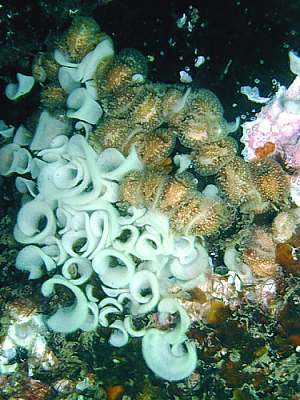
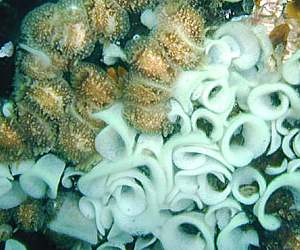
Dear Bill,
Here is another record of Onchidoris bilamellata spawning. We encountered several patches of animals and spawn, as the attached image, while diving on 13 July 2003 from the shore at Dunbar on the east coast of Scotland. The animals were found at depths around 6-7 metres at two sites separated by approx 8oo metres and although not in the prolific numbers observed by me previously, this was another mass event I believe. Water temp was 12 deg C on a gloriously sunny day.
Kind regards
Jim A
jander4454@blueyonder.co.uk
Anderson, J., 2003 (Jul 18) Onchidoris bilamellata spawning. [Message in] Sea Slug Forum. Australian Museum, Sydney. Available from http://www.seaslugforum.net/find/10454Thanks Jim,
From earlier reports on the Forum it looks like mass spawning occurs in the UK region from at least July to September, and from August to December in California. It certainly appears to be a spectacular sight - perhaps not quite up there with coral spawning - but close
Cheers,
Bill Rudman
Onchidoris bilamellata - swarming in Scotland again.
October 23, 2002
From: Jim Anderson
Dear Bill,
We observed a swarm of these little animals at 24 metres on a reef in Loch Nevis on the west coast of Scotland. Sorry but I have no photos but there were several hundred of them with spawn. Sea temp was 14 deg C. This is only a few miles from the site we saw a similar event in August 2001 - see http://www.a4454.freeserve.co.uk/onchidoris-bilamellata-06.html for details of that event and http://www.a4454.freeserve.co.uk/onchidoris-bilamellata-03.html for details of a previous event in 2000.
Regards,
Jim A
jander4454@aol.com
Anderson, J., 2002 (Oct 23) Onchidoris bilamellata - swarming in Scotland again.. [Message in] Sea Slug Forum. Australian Museum, Sydney. Available from http://www.seaslugforum.net/find/8252Thanks Jim,
From your records and the others already on the Forum from California and Ireland, these breeding swarms seem to be a normal occurrence for this species. It would be interesting to know if these breeding swarms are the result of them all migrating to 'breeding grounds' or whether its the result of all the animals in one area just reaching maturity at about the same time.
Best wishes,
Bill Rudman
Onchidoris bilamellata - California swarming (1)
December 13, 2001
From: Clinton Bauder
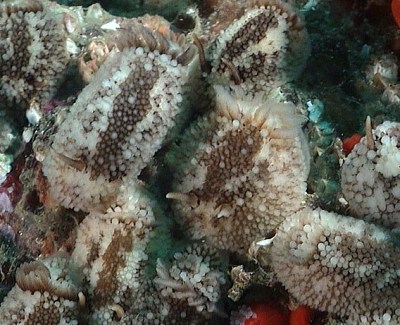
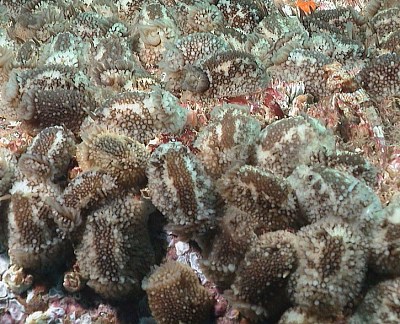
Hi Bill,
Following my earlier message here are some pictures of Onchidoris bilamellata swarming in Carmel. Photos showing egg laying are in a separate message.
Clinton
gecko1@apple.com
Bauder, C., 2001 (Dec 13) Onchidoris bilamellata - California swarming (1). [Message in] Sea Slug Forum. Australian Museum, Sydney. Available from http://www.seaslugforum.net/find/5820Thanks Clinton,
Bill Rudman
Onchidoris bilamellata - California swarming (2)
December 13, 2001
From: Clinton Bauder
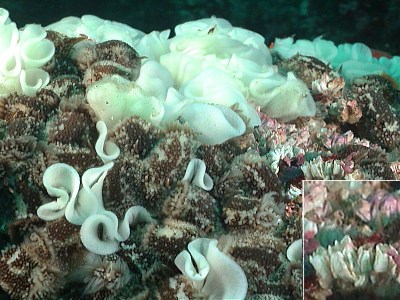

Hi Bill,
To accompany my other message here are some pictures of swarming Onchidoris bilamellata in Carmel laying eggs. One thing to note is the large number of small barnacles in the bottom of the lower picture [also see inset in upper photo]. I believe these are Balanus crenatus. We've had an incredible bloom of these barnacles lately. They literally covered everthing; bryozoans, hydrocorals even kelp. I'm guessing the current explosion of this barnacle-eating nudibranch is a natural response to the barnacle bloom.
Clinton
gecko1@apple.com
Bauder, C., 2001 (Dec 13) Onchidoris bilamellata - California swarming (2). [Message in] Sea Slug Forum. Australian Museum, Sydney. Available from http://www.seaslugforum.net/find/5827Dear Clinton,
Celeste's question about 'conga lines' of slugs certainly has opened our eyes to a very interesting phenomenon from California to Scotland and Ireland. While high population numbers certainly suggest an abundance of food, why they should swarm, and trail, is a puzzle. Another question which arises is whether this swarming is a common phenomenon. Although there have been no published reports of this phenomenon since Pelseneer (1922), that does not necessarily mean that they haven't been busily swarming on a regular basis. Certainly something else to keep an eye out for in the future.
Best wishes,
Bill Rudman
Onchidoris bilamellata swarming in California
December 10, 2001
From: Clinton Bauder
Hi Bill,
Just wanted to send a note out saying that I saw several incredibly large aggregations of Onchidoris bilamellata in Carmel [California]today. They literally carpeted every square mm of the reef in places. I'll send some pictures when I get a chance. The two sites I saw them were Honeymoon Rocks which is just south of Point Lobos and Pescadero Point. Both aggregations were in about 30m of water.
Figured this might be of interest to the California branching crowd. This was a new branch for me. Pretty bizzare to not only find a new species but to literally see thousands of them!
Clinton
gecko1@apple.com
Bauder, C., 2001 (Dec 10) Onchidoris bilamellata swarming in California. [Message in] Sea Slug Forum. Australian Museum, Sydney. Available from http://www.seaslugforum.net/find/5798Dear Clinton,
Considering that this animal is supposedly a resident of both sides of the North American continent and western Europe, sightings like this are not just of interest to the California crowd. I look forward to some photos. Hopefully they will help comfirm the identity of this 'swarmer'.
Best wishes,
Bill Rudman
Re: Conga lines of brown nudis in California
November 16, 2001
From: Dave Behrens
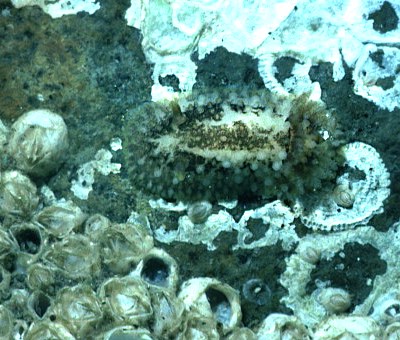
Hi Bill:
Concerning Celeste's conga line ... after a couple interactions with her we believe mystery critters to be Onchidoris bilamellata (Linnaeus, 1767) which Gary McDonald and I have on rare occasions observed in large aggregations. Adults of this species feeds on acorn barnacles while juveniles feed on encrusting bryozoans. Gary and I are at a loss to explain the tailing behavior Celeste observed, however. Pretty interesting observation. The attached photo of Onchidoris bilamellata was taken by Hans Bertsch at Hat Island, Washington in 1995.
Dave Behrens
dave@seachallengers.com
Behrens, D., 2001 (Nov 16) Re: Conga lines of brown nudis in California. [Message in] Sea Slug Forum. Australian Museum, Sydney. Available from http://www.seaslugforum.net/find/5675Dear Dave,
When I replied to Celeste, I remembered Tom Thompson's 'refutation' of Pelseneer's (1922) observations concerning Onchidoris bilamellata in France but thought that as it was essentially an intertidal animal it was unlikely to be what Celeste was describing. I had forgotten O. bilamellata has been recorded from up to 20m deep. Pelseneer described great swarms of spawning animals migrating up and down the shore with the tide and 'following the leader' in lines like processional caterpillars. Pelseener's observations have never been reported by other observers and Thompson, on the basis of one visit to the site of Pelseneer's observations, published his 'refutation' of this behaviour. From Celeste's observations, and from Bernard Picton's message, Pelseneer did not concoct his observation. Onchidoris bilamellata is apparently swarming from the northeastern Pacific to the northeastern Atlantic.
Reference:
• Pelseneer, P. (1922) Sur une habitude de Doris bilamellata. Annls. Soc. roy. zool. Belg., 53: 28-32
• Thompson, T.E. (1984) Migrations of Onchidoris bilamellata during tidal emersion: a refutation. Journal of Molluscan Studies, 50(2): 123.
Best wishes,
Bill Rudman.
Re: Conga lines
November 16, 2001
From: Bernard Picton
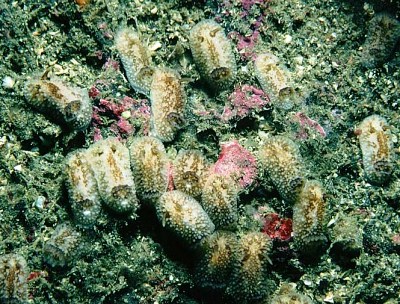
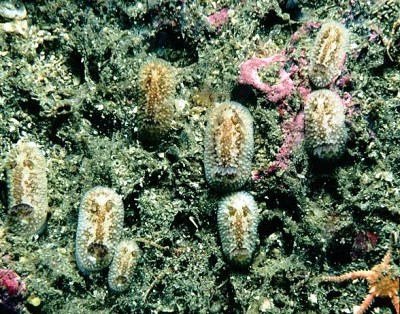
Hi Bill,
Concerning Celeste's message I saw Onchidoris bilamellata behaving like this off the Aran Islands, Co. Galway, Ireland in early September 2001. All the animals were about 10-15mm in length and they were aggregating to spawn. In places the entire seabed was covered with individuals all facing in the same direction like an army on the march! They were climbing up onto sponges and soft corals and anything firm sticking up off the seabed to lay eggs where the current would catch them. The seabed was flat limestone with some loose shelly gravel in a slight current. I guess the shelly gravel is partly barnacle plates.
At about the same time Jim Anderson saw the same thing off Scotland. If the population is continuous between us this must be the most common nudibranch on the planet!! ;-)
Onchidoris bilamellata is supposed to be circumboreal and to occur off the entire west coast of the USA so Celeste's animal could be this species.
Bernard
bernard.picton.um@nics.gov.uk
Picton, B.E. , 2001 (Nov 16) Re: Conga lines . [Message in] Sea Slug Forum. Australian Museum, Sydney. Available from http://www.seaslugforum.net/find/5688Dear Bernard,
Thanks for these wonderful photos and observations. I have put two of your photos of the egg masses in a separate message. As I commented in Dave Behren's message, it looks like Pelseneer wasn't seeing things in 1922 when he reported this phenomenon.
Best wishes,
Bill Rudman
Re: Onchidoris bilamellata swarming
November 16, 2001
From: Bernard Picton
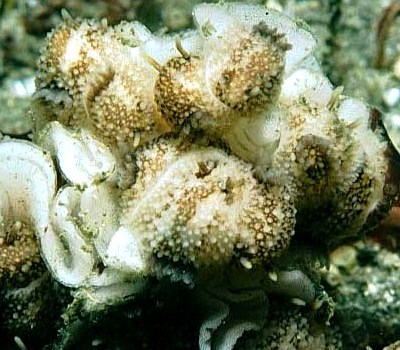
Dear Bill,
To accompany my message about the swarming behaviour of Onchidoris bilamellata, here are some other photos from the same dive. They include an aggregation of egg masses, and animals swarming over another group of egg masses.
Cheers,
Bernard Picton
bernard.picton.um@nics.gov.uk
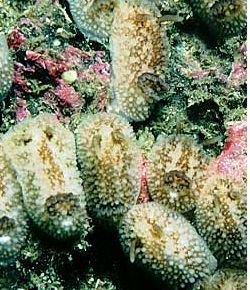
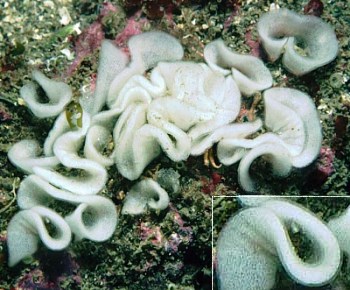
Thanks Bernard,
Bill Rudman
Conga lines of brown nudis in California
November 14, 2001
From: Celeste Fowler
A month or two ago we saw large numbers of a type of nudibranch we hadn't seen before. Basic body plan of a sea lemon (rough surface, cirri on the front, gills on the back) except smaller (about an inch long) and brown/tan mottled coloration, almost camouflaged. What was interesting is that they were out in droves. Mainly following each other in lines, but in some places they looked like some kind of 70's shag carpet. Never seen that before!
Monastery Beach in Monterey, California at around 70 feet on coarse sand near a rocky reef. Couldn't find them in Sea Challengers!
Any hints?
Thanks much!
Celeste Fowler
celeste_fowler@yahoo.com
Fowler, C., 2001 (Nov 14) Conga lines of brown nudis in California. [Message in] Sea Slug Forum. Australian Museum, Sydney. Available from http://www.seaslugforum.net/find/5665Dear Celeste,
If it looked like a typical dorid [sea lemon = Anisodoris nobilis] then this trailing behaviour is not one I would normally associate with most dorids. If you had said a Sea Hare, I would not have been surprised. But I have no personal experience of peculiar Californian behaviours so I will wait for a reply from our colleagues from that part of the world.
Best wishes,
Bill Rudman
Re: Onchidoris bilamellata
June 23, 2001
From: Irina Roginskaya
Dear Bill,
I am sure that the nice brown Onchidoris from the message of Paul Young is O. bilamellata - our White Sea [NW Russia] specimens of O. bilamellata are looking just the same.
Best wishes,
Irina Roginskaya.
irina7@hotmail.com
Roginskaya, I, 2001 (Jun 23) Re: Onchidoris bilamellata. [Message in] Sea Slug Forum. Australian Museum, Sydney. Available from http://www.seaslugforum.net/find/4642Thanks Irina,
Bill Rudman
Re: Onchidoris bilamellata
June 23, 2001
From: Marli Wakeling
This looks like the correct identification to me: we have this little critter, too in British Columbia, Canada. I find it fascinating that we have the same creatures, although divided by a huge land mass!
Marli Wakeling
scubamarli@excite.com
Wakeling, M., 2001 (Jun 23) Re: Onchidoris bilamellata. [Message in] Sea Slug Forum. Australian Museum, Sydney. Available from http://www.seaslugforum.net/find/4652Thanks Marli,
Bill Rudman
Onchidoris bilamellata from New England
June 21, 2001
From: Paul Young


Dear Bill,
Locally this animal is called the Rough-Mantled Nudibranch. We believe it is Onchidoris bilamellata.
It is found on rocks and spawns on rocks. It is 2-3 cm. This photo was taken off Mount Desert Island, New England, USA [Atlantic coast] but we have seen them as far south as Rhode Island.
Paul Young
young@underwater.org
Young, P., 2001 (Jun 21) Onchidoris bilamellata from New England. [Message in] Sea Slug Forum. Australian Museum, Sydney. Available from http://www.seaslugforum.net/find/4619Dear Paul,
I am sure if it is not Onchidoris bilamellata someone will let us know
Best wishes,
Bill Rudman
